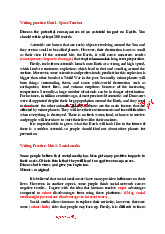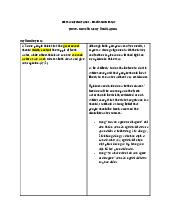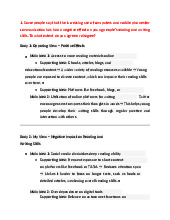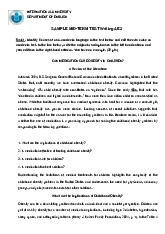





Preview text:
lOMoAR cPSD| 58137911
INTERNATIONAL UNIVERSITY DEPARTMENT OF ENGLISH SAMPLE MID-TERM TEST Writing AE2
Task 1: Identify 6 cases of non-academic language in the text below and edit them to make an
academic text. In the box below, write the original words/phrases in the left hand column and
your editions in the right-hand column. You have an example. (30 pts)
CAN MEDICATION CURE OBESITY IN CHILDREN?
A Review of the Literature
In March 2004, U.S. Surgeon General Richard Carmona called attention to a health problem in the United
States that, until recently, we have overlooked: childhood obesity. Carmona highlighted that the
“astounding” 15% child obesity rate constitutes an “epidemic.” Since the early ‘80s, that rate has
“doubled in children and tripled in adolescents.” Now more than nine mil ion children are classified as
obese. While the traditional response to a medical epidemic is to hunt for a vaccine or a cure-all pil ,
childhood obesity has proven more elusive. Lacking success of recent initiatives suggests that
medication mightn’t be the answer for the escalating problem. In this literature review, I wil consider
whether the use of medication is a promising approach for solving the childhood obesity problem by
responding to the following questions:
1. What are the implications of childhood obesity?
2. Is medication effective at treating childhood obesity?
3. Is medication safe for children?
4. Is medication the best solution?
Understanding the limitations of medical treatments for children highlights the complexity of the childhood
obesity problem in the United States and underscores the need for physicians, advocacy groups, and
policymakers to search for other solutions.
What Are the Implications of Childhood Obesity?
Obesity can be a devastating problem from both an individual and a societal perspective. Children are
put at risk by obesity for a number of medical complications, including type 2 diabetes, hypertension, lOMoAR cPSD| 58137911
sleep apnea, and orthopedic problems (Henry J. Kaiser Family Foundation, 2004, p. 1). In the Table 4
below, researchers Hoppin and Taveras (2004) have said that obesity is often associated with
psychological issues such as depression, anxiety, and binge eating.
Obesity also poses serious problems for a society struggling to cope with rising health care costs. The
cost of treating obesity currently totals $117 bil ion per year—a price, according to the Surgeon General, is
“second only to the cost of [treating] tobacco use” (Carmona, 2004). Of course, as the number of children
who suffer from obesity grows, long-term costs wil increase. …
Source: Diana Hacker (Boston: Bedford/St. Martin’s, 2006).
Write your answer here. No. Original word/phrase
Possible edited word/phrase 0 ‘80s 1980s 1 2 3 4 5 6
Task 2: Read the text below and create a graphic display or an outline that categorizes the points
made in the text in the next page. (20 pts)
SOLVING SCHOOL CHEATING
In my years of teaching, no student has ever admitted to a plagiary, even when questioned. The closest
admission which I get is that someone "read it over for me," or "I used my dictionary." It is a hard truth:
even when they are caught, cheaters continue to cheat. However, there is no harder task for a teacher
than to give a "0"! There are some common factors of cheating which need to be actively chal enged.
Students cheat primarily to make their lives easier. Young people, under heavy parental pressure, find
cheating a way to meet their parents' expectations. It is better to cheat than to have parents scold them
again and again. Recently in schools, the question which is often heard is, "What did you get?" Peer
pressure is another reason for student cheating. It is undesirable to say "I got a 'C'", especially in today's lOMoAR cPSD| 58137911
competitive schools. It is possible that the most important reason for cheating is what Katie Hafner referred
to as "mental softness." It is the Internet that bears responsibility in this case. On the Internet, ideas and
words used to express ideas can be accessed easily. Why do students have to think hard if the information
is substantially provided? An easy life is available to the student cheater: a life without parental nagging,
ridicule at school, or the need to work hard.
With such "softness" evident in our students, the solutions to cheating must be hard ones. Parents need
to accept their children's abilities, and to celebrate their accomplishments, no matter how small they are.
Heavy pressure, by itself, cannot make a child smarter. Students must be encouraged to make
comparisons on how much a peer has improved and on how hard that person had to work in order to
obtain a grade. For some students, a "C" is a major achievement. The hardest chal enge wil be to reshape
the Internet as a tool for creating higher order thinking, not one for avoiding difficult work. Teachers, instead
of trying to keep students away from Internet resources, must make themselves aware of the Internet's
potential for teaching. Research-based assignments (properly cited) that use the Internet should be
assigned in every classroom. In these ways, we can work on the soft attitudes and remake them into a passion for disciplined work.
Cheating is a danger to student achievements, one that needs to be chal enged vigorously. Parents,
who always want to see geniuses in their family and put frequent pressure on their children, should learn
to ease up to some extent. Students can learn to admire each other's accomplishments without resorting
to comparisons that offer little in judging a person's true worth. Furthermore, teachers can learn from their
mistakes and begin to bring the Internet into their secluded classroom worlds. If we work on this together, our success wil be assured.
The graphic display or outline:
……………………………………………………………………………………………………………………….
……………………………………………………………………………………………………………………….
……………………………………………………………………………………………………………………….
……………………………………………………………………………………………………………………….
……………………………………………………………………………………………………………………….
……………………………………………………………………………………………………………………….
……………………………………………………………………………………………………………………….
……………………………………………………………………………………………………………………….
……………………………………………………………………………………………………………………….
……………………………………………………………………………………………………………………….
……………………………………………………………………………………………………………………….
………………………………………………………………………………………………………………………. lOMoAR cPSD| 58137911
……………………………………………………………………………………………………………………….
……………………………………………………………………………………………………………………….
Task 3: Write a compare/contrast essay (about 300 words) about life in Vietnam now and a
decade ago. Pay attention to the use of academic language and a clear text structure (50 pts)
……………………………………………………………………………………………………………………….
……………………………………………………………………………………………………………………….
……………………………………………………………………………………………………………………….
……………………………………………………………………………………………………………………….
……………………………………………………………………………………………………………………….
……………………………………………………………………………………………………………………….
……………………………………………………………………………………………………………………….
……………………………………………………………………………………………………………………….
……………………………………………………………………………………………………………………….
……………………………………………………………………………………………………………………….
……………………………………………………………………………………………………………………….
……………………………………………………………………………………………………………………….
……………………………………………………………………………………………………………………….
……………………………………………………………………………………………………………………….
……………………………………………………………………………………………………………………….
……………………………………………………………………………………………………………………….
……………………………………………………………………………………………………………………….
……………………………………………………………………………………………………………………….
……………………………………………………………………………………………………………………….
……………………………………………………………………………………………………………………….
……………………………………………………………………………………………………………………….
……………………………………………………………………………………………………………………….
……………………………………………………………………………………………………………………….
……………………………………………………………………………………………………………………….
………………………………………………………………………………………………………………………. lOMoAR cPSD| 58137911
……………………………………………………………………………………………………………………….
……………………………………………………………………………………………………………………….
……………………………………………………………………………………………………………………….
……………………………………………………………………………………………………………………….
……………………………………………………………………………………………………………………….
……………………………………………………………………………………………………………………….
……………………………………………………………………………………………………………………….
……………………………………………………………………………………………………………………….
……………………………………………………………………………………………………………………….
……………………………………………………………………………………………………………………….
……………………………………………………………………………………………………………………….
……………………………………………………………………………………………………………………….
……………………………………………………………………………………………………………………….
……………………………………………………………………………………………………………………….
……………………………………………………………………………………………………………………….
……………………………………………………………………………………………………………………….
……………………………………………………………………………………………………………………….
……………………………………………………………………………………………………………………….
……………………………………………………………………………………………………………………….
……………………………………………………………………………………………………………………….
……………………………………………………………………………………………………………………….
……………………………………………………………………………………………………………………….
……………………………………………………………………………………………………………………….
……………………………………………………………………………………………………………………….
……………………………………………………………………………………………………………………….
……………………………………………………………………………………………………………………….
……………………………………………………………………………………………………………………….
……………………………………………………………………………………………………………………….
………………………………………………………………………………………………………………………. lOMoAR cPSD| 58137911
……………………………………………………………………………………………………………………….
……………………………………………………………………………………………………………………….
……………………………………………………………………………………………………………………….
……………………………………………………………………………………………………………………….
……………………………………………………………………………………………………………………….




